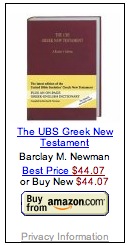The UBS Greek New Testament: A Readers Edition (A Hands-On, Comparative Review)
12/10/2007 17:18 Filed in: Faith & Reason | Books & Literature
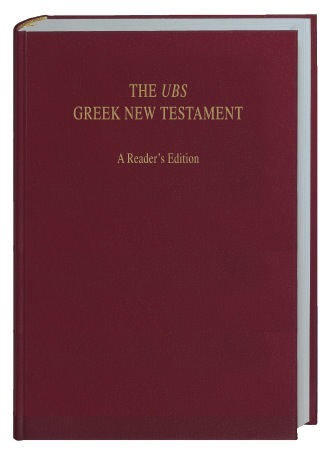
If you haven't read it already, I highly recommend that you see my earlier review of A Reader's Greek New Testament, 2nd Edition from Zondervan for a greater context in understanding this review. If you don't have time to do that, there are four things you should know right up front:
- The UBS Greek New Testament: A Reader's Edition (henceforth UBSRE), is similar in nature to Zondervan's A Reader's Greek New Testament (RGNT from this point forward) which has been published in two separate editions. The first was based upon the Greek text underlying the NIV, and the second is based upon the Greek text underlying the TNIV. All three of these New Testaments include a Greek text with a vocabulary apparatus at the bottom of the page containing definitions for all words that occur less than 30 times in the New Testament. The purpose of such an edition is to allow the reader with at minimum a basic foundation of Greek study to simply read the New Testament in Greek without having to constantly consult a lexicon for words not in one's working knowledge.
- As I explained in the previous review of the RGNT2, although I originally bought the Zondervan RGNT1 for the novelty of having the underlying NIV text, I actually found the volume quite useful, especially as a tool to throw into my book bag that I carry to church on Sundays. I found the idea of a Reader's New Testament in Greek with the vocabulary apparatus is extremely handy when I simply needed to consult the text and wasn't worried about text critical issue or didn't have the time to look up complete definitions in my BDAG lexicon.
- I was never fond of the italic text in the RGNT1, but it was bearable. I was extremely disappointed in the release of the RGNT2 in that although the text was changed to a non-italic font, it used a style with thinner character strokes that actually made the text more difficult to read in my opinion.
- Finally, about a year or so ago, a professor at a seminary extension contacted me wanting to know if I had heard whether the RGNT was being discontinued due to threat of a lawsuit from the United Bible Societies or the German Bible Society. I could not confirm any such lawsuit at the time or that the RGNT was being taken off the market (it was not). However, I did confirm from an off-the-record source recently that there was talk of an actual lawsuit, but it was deemed that since the standard eclectic Greek New Testament is based upon public domain ancient manuscripts, such a suit would not be able to stand up in court.
I'm happy to report that nothing ever came of the lawsuit talk. I would have greatly disappointed (especially in light of 1 Cor 6:1ff) if one Bible publisher had decided to sue another Bible publisher. Rather, the German Bible Society decided to create their own edition of a Greek New Testament similar to Zondervan's RGNT. The UBS version, however, is based upon the UBS Greek New Testament, fourth revised edition. The main features of the UBSRE include the following:
- Translation of all vocabulary items occurring 30 times or less in the New Testament at the bottom of the page
- Translations given according to context
- Definitions of idiomatic word combinations
- Grammatical analysis of all difficult verb forms
- Reader-friendly layout enabling the reader to transfer easily from text to dictionary and vice versa
- An appendix providing translations of all vocabulary items occurring more than 30 times in the New Testament
- The maps from the USB Greek New Testament.
I find it impossible to review the UBSRE without reference to Zondervan's RGNT, so I would prefer to offer a comparative review. From the outset, the immediate difference between these two is size. Although, both have about the same dimensions in height and width (both volumes are around 6" x 9"), the UBSRE is essentially twice as thick as the RGNT. Zondervan's product page for the RGNT states that it contains 576 pages, while the German Bible Society's product pages lists the UBSRE at 712 pages. So why is the UBSRE twice is thick as the competing product, even though it is less than 200 pages longer? Well, it has to do with the very thin paper and space-conserving format used in the RGNT, but I'll write more about that in a moment.

Admittedly, I like the soft, leather-like Italian DuoTone cover on the RGNT better than the hardcover binding of the UBSRE. The Zondervan product feels like a Bible, while the UBS edition feels like a book. The UBSRE is bound in what has become the signature burgundy cover with gold lettering that is used with most editions of the UBS Greek New Testament. However, I know that they also produce flexible covers, and I believe one would be appropriate for this edition.
Nevertheless, it's what's inside that counts, and this is where the UBS shines. I'll get to the layout issues in a moment, but first a few comments on the vocabulary apparatus. The apparatus itself is referred to in the introduction and on promotional materials as a "Running Greek-English Dictionary." The RGNT has this, too, of course, but the UBS edition may just be better. The definitions have been adapted from Barclay Newman's Concise Greek-English Dictionary of the New Testament contained in many UBS editions of the Greek New Testament. Of course, because of space, the definitions have been shortened based upon the context. Therefore, the the contextual decision may theoretically imply some amount of interpretation upon the editor's part, but this would not be any different from using Trenchard's glosses in the RGNT. Further, the running dictionary is not meant to replace use of a lexicon, but merely to allow quick access to the meaning of the text in certain contexts.
The UBSRE also breaks with the Zondervan editions in that it offers grammatical help on what the editors consider more difficult forms. So for instance, in John 1:42, both the UBSRE and the RGNT offer a definition for ἐμβλέψας. The RGNT: "ἐμβλέπω, I look at, consider." The UBSRE: "ἐμβλέπω aor act ptc m.s.nom, look straight at." For many readers, this extra grammatical information is going to be very helpful.
Like the RGNT2, the UBSRE also offers a mini glossary of Greek vocabulary words occuring more than 30 times (the ones that don't get listed with the text) in case the reader simply forgets what shoudl be a memorized word. But this is also a place where the two editions differ greatly. The word list in the RGNT2 is based on Warren C. Trenchard's Complete Vocabulary Guide to the Greek New Testament, so it's definitions are fairly short as one would expect. So, for instance, if one were to look up ἀγαθός in the RGNT2 appendix, would would find this entry: "ἀγαθός, ή, όν (102) good" (the numeral indicates how many times the word occurs in the Greek NT). However, because the definition appendix in the UBSRE bases its entries on Barclay Newman's dictionary, one will find a much more detailed entry: "ἀγαθός, ή, όν good; useful, satisfactory for one’s (its) purpose, fitting, beneficial; sound (of trees), fertile (of soil), happy (of days); in a moral sense upright, just; kind, generous; clear (of conscience); perfect, inherently good (of God); τὸ ἀγαθόν the good, what is good; what is right or upright; what is beneficial or advantageous; τὰ ἀγαθά goods, possessions; good things (Lk 16:25); good deeds (Jn 5:29)." That's quite a difference, but to be fair, one could argue that the RGNT2 offers the most essential information with the understanding that more detail can be derived from other resources. But again, for some readers, this extra information will be seen as quite helpful. I should also point out that the glossary in the RGNT only fills a little less than six pages, while the corresponding feature in the UBSRE fills 22 pages.
This leads me to what I believe is the most significant difference between the UBSRE and the RGNT2: layout and readability. The UBSRE is simply easier to read than the RGNT2. It's font is larger and the text is laid out leaving more white space on the page. Further, the running vocabulary list in the UBSRE runs in a two-column list which allows one to easily find the word he or she is looking for.
I took my own scans of each edition for this review rather than relying on the PDFs made available from each publisher. I thought this might give a fairer comparison between each edition. If the lines don't seem quite straight, it's from a less than perfect attempt on my part to hold the volume flat on my scanner.
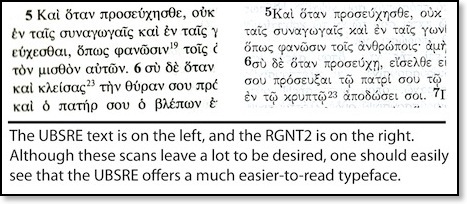
As I stated in the review of the RGNT2, part of the problem comes from my perception that Zondervan, normally a maker of quite excellent reference works, has an unhealthy preoccupation with thinline Bibles. Since the RGNT is a New Testament, someone in marketing or layout and design must have suggested than a thinline form factor be adopted. I'll be the first to admit, that the RGNT fits much more nicely in the hand than the UBSRE. However, this is strictly form over function. The UBSRE doesn't suffer from small print, cramped text, or near as much bleed through (which is even evident in the above samples) as the RGNT2. This issue is also apparent when you look at a full page spread of each edition.
[Note that neither of the scans below captured the full margins of either edition since my scanner space was smaller than a full page spread of either edition.]
First, the RGNT2 (click on the image to get a larger, more detailed view).
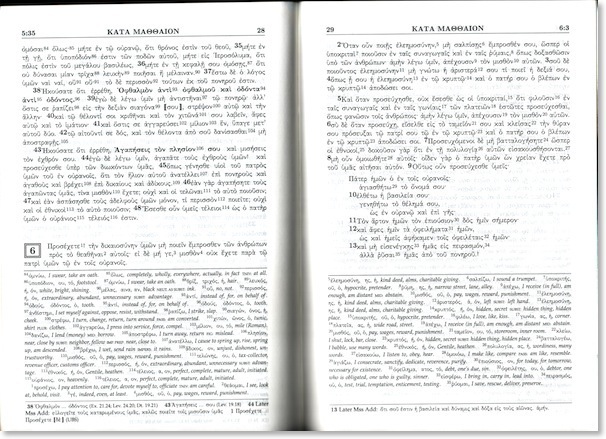
And now, the UBSRE (again, click on the image to see a larger, more detailed view):
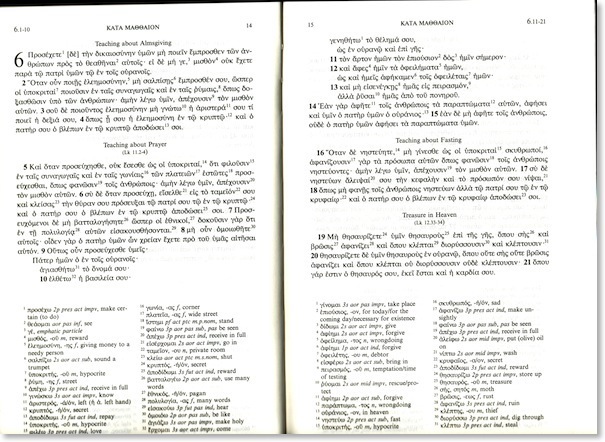
In my opinion, the UBSRE is much more inviting. Section headings separate pericopes, and parallel passages in other gospels are also noted. Of course some people prefer a straight text without section headings. If this is the case, the RGNT may be preferred to those readers. Finally, finding the definition of a word in the UBSRE is made much simpler and quicker with the two columns, rather than hunting through the paragraphed text of the RGNT's apparatus.
WHAT'S MISSING?
Not much. There's very little in the RGNT2 that's missing in the UBSRE. However, I felt the Scripture references for OT quotations in the RGNT2 were a very welcome addition, and one that the reader will not find in the UBSRE. The maps are a bit nicer in the RGNT2 than the standard UBS maps. The RGNT2 also added a few, sparse textual notes in addition those that referenced divergences from the UBS text. The reader of the UBSRE will still need to consult a more traditional edition to see textual issues.
Something should also be said about price. The UBSRE is significantly more expensive than the RGNT. I've stated for a long time that UBS prices were out of control, and this edition is no different. Even with discounts at places like Amazon or CBD, one can expect to pay about $20 more for the UBSRE over the price of the RGNT.
FINAL EVALUATION
Although initially, I was very excited about the release of the RGNT2 and its promised improvements over the first edition, I was quite disappointed in the final product. Yes, the thinline aspect of the RGNT2 might initially seem like a bonus over the twice-as-thick UBSRE, but in actual use, function simply wins out over form for me. The UBSRE is a better product because the designers of it did not choose to take shortcuts necessary to create a thinner form factor. From what I've heard, the RGNT had been greatly cutting into the sales of UBS/NA Greek New Testaments over the past few years, and the UBSRE is nothing less than a counter strike, and a significant one at that.
One last thing. If you read my review of the RGNT2, you'll remember I lamented that a ribbon marker was missing, in spite of the fact that one had been promised in early promotions, and even listed as a new feature on early shots of the box cover. Well, potential purchasers of the UBSRE will be glad to know that it does, in fact, come with a ribbon marker. Admittedly a minor detail, but handy for any reader, nonetheless.










